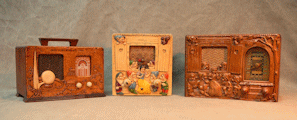Emerson Snow White Model Q236 Radio (1939)




This 1939 Emerson model Q236 "Snow White" is charming, unique, and
colorful, one of the most desirable novelty radios ever made.
Emerson made two versions of the Snow White radio, under license with Disney
and capitalizing on the success of the 1937 animated
film. This one is cube-shaped
and colorfully painted. Snow White and the dwarfs caper in front of their
cottage, while Dopey and a squirrel peek down from atop the shutters.
The window forms the dial, with markings around its borders.


I purchased this radio from the son of the original owner, who received it
as a gift when he was a child. The radio is in outstanding original condition.
The only sign of wear is on the acorn-shaped knobs.
I also own the second version of the Emerson Snow White, Model 247,
which is larger and colored a natural brown:

Although similar on the outside, these radios have different chassis inside.
In the larger Model 247, the dial is framed by the cottage door, to the
right of the fairytale figures. The knobs are located on either side of
the cottage steps, rather than amongst the figures as in Model Q236.
My radio has its original wooden back, which states the model number
and has a little metal plate stamped with the Emerson musical logo.

The cloth-covered power cord is missing its plug. The owner mentioned that his
grandfather removed the plug for safety reasons at some point. It also has
the original cloth-covered antenna wire, which is stretched out for best reception.
With the back removed, you can see that the radio chassis is a very tight fit:

Early radios were bulky and expensive, and throughout the 1930s, manufacturers
competed to make "midget" radios that were smaller and more
economical. This Snow White is as small as anyone could make a four-tube radio
in 1939, given the octal tubes available at the time. (All-glass
"mini" tubes had just been invented, and they would not
become affordable until after the war.)
I haven't restored the electronics yet, and I may leave them alone indefinitely.
With most radios, electronic restoration has no great effect on the value, but
this one is in such wonderful original condition that I like the idea of leaving
it completely untouched. Besides, you can't expect world-class performance
from a four-tube 1930s TRF (tuned regenerative frequency) radio. It should
receive strong, local stations well, but that's about it.
You will find the schematic for this radio under
Model Q157
in Rider's. As with my other Emerson Snow White, the company denoted the
chassis with a letter (here, Q) and the cabinet (here, 236) with a number.
If you are shopping for a radio like this, the condition of the paint is
all-important. Most surviving examples are in poorer condition than mine,
with chipped, worn paint or faded colors. Beware of a radio that looks
"too new." If you can't see any wear at all, particularly on the
knobs, it may have been repainted, which would decrease the value.
Buyer Beware! You should also beware of fakes. The chassis used in this radio
was also used in other Emerson radios, and it's easy to cast
a reproduction front panel, as mentioned in my Emerson 247
article. The rest of the cabinet
is a simple wooden box, so the fake consists of a chassis from another radio,
a new wooden cabinet and a plastic front panel, all painted to look
original.
Fake Snow White radios have been circulated since the 1990s,
if not earlier, so before purchasing one of these make sure
it is the genuine article. It's not difficult to detect a fake panel, as
explained in my other article. Keep in mind that an
original—even one that was rarely used—will have some telltale marks
of everyday wear that are trickier to replicate than daubing
blue paint on a dwarf's hat.
The final photo shows both of my Snow White radios alongside a third set that
uses a figural repwood front panel, my RCA
40X-56.

The RCA radio commemorated the 1939 New York World's Fair rather than a movie.
Viewed together, these three sets make an interesting trio.
|